Antigua and Barbuda
This post we’ll examine some of the design elements of our Nordic tipis further, and as we touched upon in our fabrics Post, one seemingly minor change in, say fabric weight can have repercussions on a wide range of other parameters. The key design features of our ventilation system, we’ll expand upon in a following Post.
In a similar way, altering design elements changes the whole, and in this Post, we’ll provide a good general understanding of our 19 key design features, showing how these interact. This is, in essence, a very general overview, and you should refer to the specific tent model to obtain a specific tipi specification.
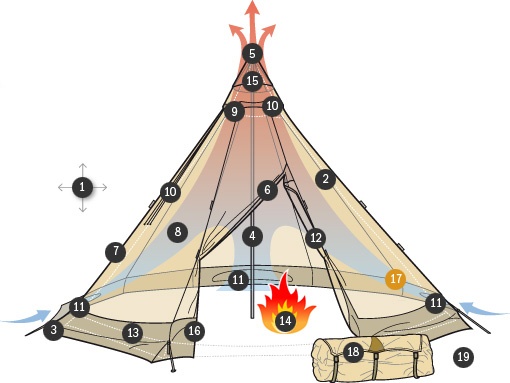
1. This refers to the optimum ratio of height to diameter at floor level, which not only gives good headroom but creates a natural chimney effect to remove fumes, or to keep the tent cooler in the summer months. An increase of this height needs to be balanced against decreasing stability, whilst decreasing the height produces a squat, low profile, less effective in sloughing off snow fall.
2. Tent fabric. This was covered in some detail in an earlier post. It is worth considering that some tent manufacturers use fabrics with only around 20% of the tear strength of our lightest fabrics. Our fabrics have high tensile strength combined with high tear strength – key factors in preventing and protecting from rips. A word of caution regarding your choice of fabric. Some cotton-polyester fabrics use a coating to achieve water-repellency. This reduces breathability significantly, and isn’t a durable option. We impregnate our Cotpolmex fabrics with a long-lasting and highly water-repellent agent, which achieves high breathability too. Re proofing over time is a straightforward job.
3. Fabric stress relief. All tent designs place fabrics and seams under stress, especially during storm conditions, and it is the tent designer’s job to ensure that these stresses don’t exceed the fabric/component specifications, or exceed the manufacturing processes like seam stitching. Tentipi achieve this through their use of the best materials and manufacturing available, combined with carefully contoured and shaped panels which spread rather than concentrate stress. Critical areas are given extra protection through the use of reinforcing tapes or broad fabric webs.
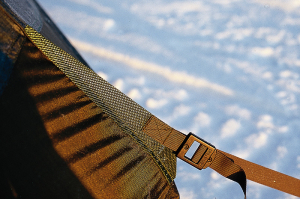
4. Central pole. 5- section, shock corded, and made from a high strength, low-weight aluminium alloy (See Post on “Fabrics and Materials”). The process of joint contraction we use improves joint strength significantly. Your single, central pole also allows pitching very quickly.
5. Central pole cap. This is the construction from which the tent itself is suspended. We use a high quality braided nylon, chosen for its strength and durability, and which has proven itself over many years of use throughout our Adventure Nordic tipi range.
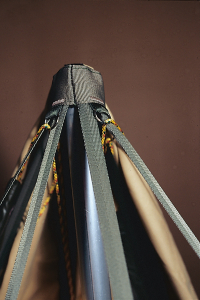
6. We pay particular attention to the main door zip. Heavy duty, and with a broad storm flap and additional seam stress protection in the form of a strong triangular fabric web where the zip meets the main fabric panel.
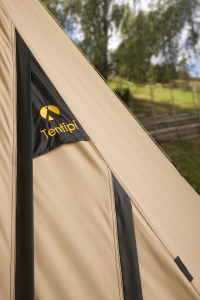
7. Guy line holders. A simple yet effective means of storing guy lines – ready for speedy use in stormy weather, without tangling.
8. Tent fabric – ventilation. Our previous post covered the choice of fabric in some detail. Our coated fabrics are fully waterproof, but they don’t breathe. We design-in features to our Nordic tipis to counteract this and improve air-flow. Our most breathable fabric is Cotpolmex – highly water repellent and ensuring a comfortable internal climate, all year round.
9. Smoke Opening. Ensures air-flow on hot days, and removes smoke on those cooler days and nights when you’re using a fire or stove. This is one key element to our successful tent design, and we’ll be looking at it in more detail in a following post.
10. Ventilator cap and “In-Tent Vent” system. (Safir, Zirkon) These provide complete control of tent ventilation and internal climate from inside the tent – closing off the cap during stormy conditions, and allowing venting when needed. Control cords descend within easy reach. A simplified (2 cord) version is used in our Onyx.
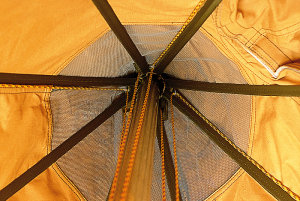 |
| In-Tent Vent, seen here with Zirkon & Safir inner tent. |
11. Large Air Intakes. These are a key component of creating a pleasant, social environment within the Nordic Tipi, as they provide a ventilation in summer and a means of regulating airflow to the fire or stove – a focal point. The Onyx combines air-flow at ground-level with venting through either the mosquito netted door, or through the partially opened main door zip. Zirkon has one additional floor level air intake, whilst Safir has three, and all these combine to provide either ventilation in the summer, or air-flow to feed the fire or stove during the colder months.
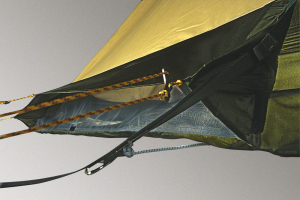 |
| Zirkon and Safir air-intakes. |
12. Door with mosquito net. The main door panel opens to reveal mosquito netting, which provides another ventilation option. Bear in mind that extremely fine woven mesh will reduce air flow significantly and provide a weak fabric. We optimise our mesh size to maximise air flow, whilst keeping mosquitoes out.
13. The inner tent. Optional. Three models are available – Base, Comfort, and Pro. These are fully interchangeable throughout our Nordic tipi range, but it is not possible to have a fire when using the Base model.
More information HERE
14. The fire. This single element alone differentiates the Nordic tipi from other designs of tent. If you’ve ever experienced camping in cold, damp, miserable conditions, the cosy atmosphere created here is quite remarkable by comparison. There’s an extra level of safety in winter, too.
15. Stove and chimney opening. The ventilator cap on Zirkon and Safir has been designed to accommodate the stove chimney – a purpose made solution when using the Eldfell Stove.
16. Reinforced edging. A 50cm wide heavy duty fabric strip runs around the tent base. Folded inwards, this can provide an extra level of protection against draughts and insects when weighed down with equipment/floor panel; folded outwards, this can provide additional stability and stormproofness when weighed down with stones, earth or snow.
17. Fastenings for accessories. We increase the versatility of our Nordic tipis by providing numerous internal fastening points for pockets and drying rail, and the inner tent attaches quickly to the outer too. Functional design features, you’ll find throughout, including floor tensioners where you need them.
18. Compression bag. This allows compression of the packed tent using lateral compression straps – especially useful in winter, with frozen tent fabric.
19. Total weight. We touched on this point in our fabric Blog Post, so you should have some understanding of the number of factors to be balanced when producing a lightweight durable tent. We believe our fabrics deliver the optimum mixture of characteristics. We then manufacture tents to the most exacting standards to meet the demands you’ll be placing upon them. Manufacturing lightweight tents is relatively simple. Manufacturing lightweight tents as good as these is a different matter.
Related blog posts
Kayaking on the Devil’s Dancefloor
Monday 21st November 2016
In this issue of the Tentipi Blog we’re embarking on a most unique adventure, taking us by kayak from the icy shores of Greenland, across the north Atlantic to the cost of north Scotland, 1200 nautical miles (2200 kilometres) from the starting point.
Dave and the incredible Olivin 2 world record
Thursday 25th February 2016
How many people can you fit into a two-person tent? Two of course! …right? Well, it may seem as a no-brainer, but by some reason that question was asked by of one of our employees during a Tentipi staff meeting about a year ago.
Wintertime Camping – Tips and Tricks
Wednesday 27th January 2016
When temperatures drop and nature turns white it’s the perfect time to bring out your Tentipi Nordic tipi for some wintertime camping. They’re not called “Nordic tipis” for nothing! Camping wintertime is fun, but it also require some extra attention from the user, so we sent Tentipi PR manager Torsten Gabrielsson out in the Swedish winter to show you some tips.
Living in my Nordic Tipi
Tuesday 4th August 2015
We’ve received a fair amount of comments, emails and messages from people, keen to extend their residency in our Nordic tipis, and here’s a Post by Jilly Sherlock telling of her own experiences through the cold, wet and high winds of a British winter.
The boy and his unicorn
Wednesday 3rd June 2015
Raised in the deep of the Swedish forests, Sigurd has a playground not many of his four-year-old fellow country men even set their feet in. In this guest post we meet this lively kid from the perspective of his pro-blogger Andrea Hejlskov. Do yourself a favour and read more of her adventurous escape into nature.
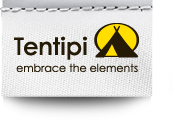
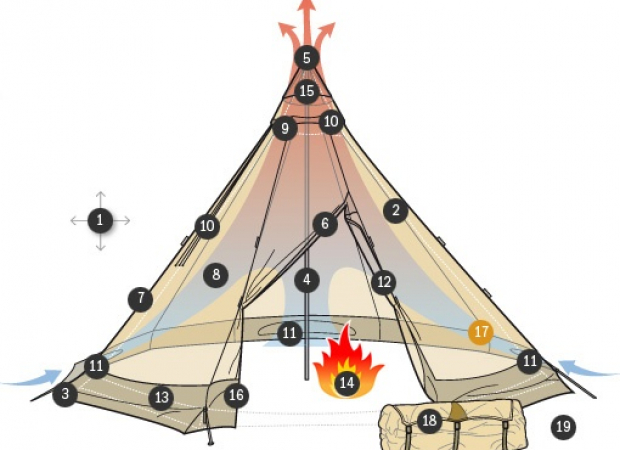





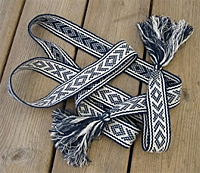


Please click the 'Add comment' button below if you wish to comment.